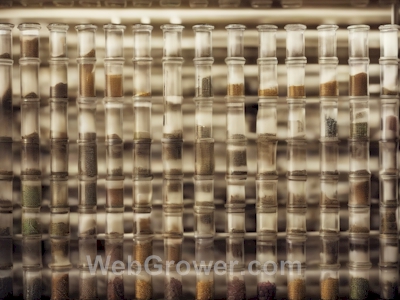Homepage → Seed Related Topics → Seed Storage and Its Affects on Quality, Viability, and Germination
Seed Storage and Its Affects on Quality, Viability, and Germination
Planted December 17, 2021
Last tended to on October 11, 2024
Reading time: 3 minutes

Basic Seed Biology:
Under the proper conditions, after a flower is pollinated (fertilized), seeds develop. Seeds consist of an embryo, some stored food material to nourish the embryo into a young plant, a life force, and a covering called a seed coat. Some seeds are tiny and contain very small amounts of stored food while others contain more than the embryo actually needs.
Seed Storage and Germination:
All seeds will eventually lose their ability to germinate and grow. There are many factors that can contribute to this – genetics, environmental storage conditions, etc.
Seeds are living organisms that require specific storage conditions in order to remain capable of producing healthy, vigorous plants. Starting with high quality seeds is essential to successful vegetable gardening and food production.
While seeds begin the process of losing their viability from the point that they are harvested, with proper conditioning and storage, some species can last for years. Many vegetable types will maintain germination rates of at least 50% for ten or more years.
For commercial vegetable production where high germination rates are a requirement, the following list provides some guidance:
- 1 year - Sweet corn, onion, parsnip, okra, parsley
- 2 years - Beet, pepper, leek
- 3 years - Asparagus, bean, carrot, celery, lettuce, pea, spinach, tomato
- 4 years - Cabbage, cauliflower, Brussels sprouts, Swiss chard, kale, squash, pumpkin, radish, turnip, rutabaga
- 5 years - Cucumber, endive, muskmelon, watermelon
For home gardening purposes, the average germination rates published by MM. Vilmorin-Andrieux in his book called “The Vegetable Garden” (1885) are useful. Click here to view.
When storing your seeds, be sure to keep them consistently cool and consistently dry. Temperature and moisture are the primary factors that cause seeds to lose their ability to germinate, and fluctuations of these factors speed the process.
Excessive seed moisture increases its respiration rate, can contribute to the growth of destructive micro-organisms, and attract insects, resulting in reduced viability. Most commercial seeds are dried to less than 10% moisture soon after harvest and held in dry storage during packaging and distribution.
Like moisture, temperature has an influence on the seed’s respiration rate. As the temperature increases, so does the respiration rate.
For short-term storage (one year to eighteen months), store seeds at 35 to 50 degrees Fahrenheit (F) with an air relative humidity (RH) level of 30 to 40%. A rule of thumb for good seed storage conditions are when the F + RH <= 100; the further you can go below a total number of 100, the better.
Aside from the conditions mentioned above, here are a few more guidelines:
-
Store in the coolest, driest location available to you avoiding temperatures over 70 degrees Fahrenheit. These conditions are easily met by placing a small packet of desiccant (which maintains a dry environment) into a tightly sealed, airtight (not airless), glass container and place in your refrigerator.
-
Make sure that the storage containers are moisture-proof.
-
Maintain a fairly constant temperature.
-
Prior to planting old seed and wasting valuable gardening time and space, perform a seed germination test.
The reality is that all seeds die over time. Even under professional storage conditions of ultra low seed moisture and subzero temperatures, seed banks must schedule regular grow outs to ensure the survival of seed varieties. Nature intended for seeds to be planted, to live a full life, and to make more seeds.
Copyright © 1998 - 2024 - All rights reserved
WebGrower.com℠ is a service mark of Victory Horticultural Group, LLC.
• Privacy Statement •
This site participates in the Amazon Services LLC Associates Program, an affiliate advertising program designed to provide a means for sites to earn advertising fees by advertising and linking to amazon.com.